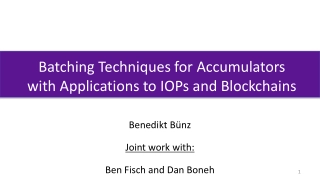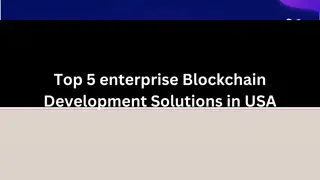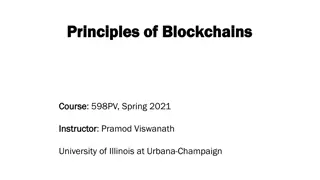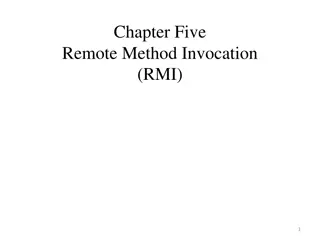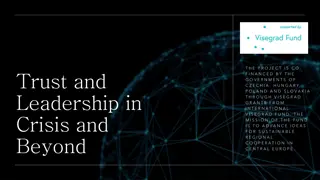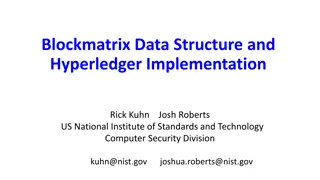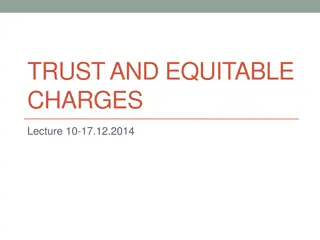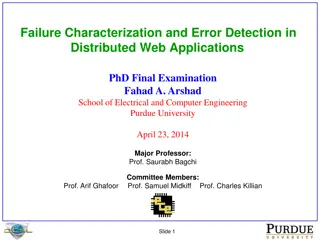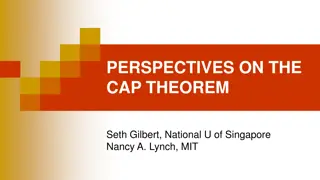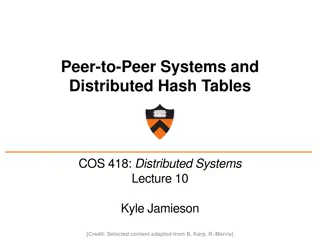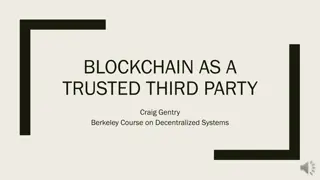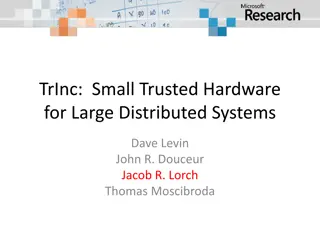Understanding Blockchains: Solving Trust Issues in Distributed Systems
Blockchains, as explained by John Kelsey from NIST, are essential for achieving mutual agreement in distributed systems without complete trust among participants. The analogy of chess-by-mail illustrates the need for consensus on the state of the board, similar to how blockchains ensure agreement on the current state of a system through a shared transaction history. Blockchains play a crucial role in scenarios like verifying Bitcoin transactions, where trust and consensus are paramount for accurate record-keeping and preventing duplication of transactions.
Download Presentation

Please find below an Image/Link to download the presentation.
The content on the website is provided AS IS for your information and personal use only. It may not be sold, licensed, or shared on other websites without obtaining consent from the author. Download presentation by click this link. If you encounter any issues during the download, it is possible that the publisher has removed the file from their server.
E N D
Presentation Transcript
Introduction to Blockchains John Kelsey, NIST https://csrc.nist.gov/csrc/media/projects/supply-chain-risk- management/documents/ssca/2016-fall/wed_am2- block_chain_john_kelsey.pdf
Overview Prologue: A chess-by-mail analogy What problem does a blockchain solve? How do they work? Hash chains Deciding what blocks are valid on the chain Deciding whether we have the current chain Permissioned blockchains, proof of work, etc. Wrapup
Warm-up: Alice and Bob want to play chess by mail Alice sends Bob 1 e4 Bob sends back 1 ... e5 Alice sends Bob 2 Nf3 ... Each of these messages is one move in the game What s necessary for them to be able to play the game?
They have to agree on the state of the board If they don t agree on the state of the board, they can t play a game! 1. Both know the starting positions of the board. 2. Both know the sequence of messages so far. Those messages make up a transcript of the game. 3. Thus, they can reconstruct the state of the board. If we agree on history, we agree on the present state of the world!
Whats that got to do with blockchain? We have some distributed system We need to all agree on the state of some system We all agree on the initial state of the system A blockchain contains a history of individual transactions Thus: We can all agree on the current state of the system A blockchain lets mutually-distrusting entities agree on history... ...which lets them agree on the state of the system now.
Why is this important? Example: Bitcoin Suppose I want to transfer 100 BTC to you. You need to know whether my account has 100 BTC in it. For that, you need to know the current state of the system. Note: You need to know the current state If you re looking at an old state of the system, I might be paying you with money I ve already spent!
What problem does a blockchain solve? A blockchain lets us agree on the state of the system, even if we don t all trust each other! Ultimate goal: We all need to agree on the state of some system. How much BTC in each account? Who owns which property? What s the current state of my program? We can all agree on that if we agree on history. Starting state + history current state We don t want a single trusted arbiter of the state of the world. We want some level of decentralization not a single point of failure or compromise.
Trusted Arbiter If we had a completely trusted arbiter, we wouldn t need a blockchain! We could just define reality as whatever TA said it was. For a payment system, imagine TA as the bank Bank provides the official sequence of transactions and account balances When you want to spend your money, you send a message to bank Bank permits transaction if you have money, and updates account balances.
Why not just have a trusted arbiter, then? 1. Single point of failure If the TA goes down for a week, the system stops working! 2. Concentration of power He who controls the past, controls the future TA can censor transactions, impose new conditions to get transactions included in history, etc. 3. Maybe there s nobody we all trust
So what does a blockchain buy us, again? Distributedsystem We don t all trust each other or any single entity We want to agree on history ...so we can agree on the state of our system... ...so we can do something. We get the functionality of a trusted arbiter... ...without needing a trusted arbiter
How does it work? A blockchain is a sequence of hash-chained records Once you ve seen record N, you can t change anything in the past. Some procedure for adding blocks to blockchain Who gets to add blocks? How is it done? Validity conditions for new blocks Are transactionsvalid? Are digital signatures correct? Etc. Enforced by consensus- chains with invalid blocks won t be accepted. Some procedure for deciding between alternative candidate blockchains. When Alice and Bob have different pictures of history, there s some way for them to eventually come to agreement about who is right.
Building Block: Cryptographic hash functions A cryptographic hash function: Takes any bitstring as an input* (Like a 10 MB file) Produces a fixed-length output (Typically 256 or 512 bits) Nobody can find collisions. Examples: SHA256, SHA512, SHA3-256, RIPEMD-160 * Sometimes there s a (really huge) maximum input length.
Whats a collision? Suppose I can find two different inputs X and Y so that Hash(X) = Hash(Y) That s a collision. For a cryptographic hash function to be any good, it needs to be collision-resistant. That just means it s impossible in practice to find colliding inputs.
Why is collision resistance useful? If nobody can find X != Y such that Hash(X) == Hash(Y), ...then we can use hash(X) as a kind of message digest of X. Digital signatures actually sign hash(message) instead ofmessage. Nobody can change X without changing hash(X) If they could do that, they can find collisions forhash() hash(X) also commits to X. Once I ve seen hash(X), later, you can show me X, and I ll know it s the value you committed to ...you can t show me some other X*, because it won t have the same hash.
Building block: Hash chains Figure: A sequence of records linked together; each record contains the hash of the previous record.
Whats a hash chain? A hash chain is a sequence of records in which each record contains the hash of the previous record in the chain, and the hash of all the current record s contents. Figure: A sequence of records linked together; each record contains the hash of the previous record.
What does that buy us? We re using a cryptographic hash function like SHA256. That means nobody can find two inputs with the same hash value. ...and that means that record N contains a commitment to record N-1 ...which contains a commitment to record N-2, which contains a commitment to record N-3, and so on. Figure: A sequence of records linked together; each record contains the hash of the previous record.
Hash chains and block chains Hash chains have the property that every record contains a commitment to all previous records. If you change record N, this changes the final hashes of records N+1, N+2, ... Result: Once we all accept record N, we have locked in the contents of record 1, 2, 3, ..., N-1 as well. Blockchains use hash chains as a component Hash chains are also useful in a lot of other contexts For example, a system with a trusted arbiter can use a hash chain to limit the arbiter s power even the arbiter can t change history.
The block chain Hash10 Hash11 Hash12 ... ... H H H H Nonce11 Nonce12 Nonce13 Trans Trans Trans 11 12 13 Figure: A block chain containing three blocks, each containing the hash of the previous block, and each containing a sequence of transactions and a nonce. Each block in the chain commits to all previous blocks and transactions
Building Block: Validity conditions What will the world accept as the nextblock? We don t have some trusted entity to decide what may be added to block chain ...so we have to decide what blocks are valid. Example: Bitcoin Signatures needed for moving BTC from an account Not allowed to leave a negative balance in an account Block must contain correct proof-of-work A proposed additional block that doesn t meet these conditions won t be accepted by the rest of thenetwork. Enforced by consensus
Forked chains Blockchains are used in distributed systems It s possible for different parties in the system to have a disagreement There s no trusted arbiter to decide who is right! Any blockchain must deal with this issue somehow! Suppose Alice and Bob no longer agree on the state of the world (because they don t agree on history) How do they come to an agreement on who s right? Several different techniques to resolve disagreements
Adding new blocks to the chain Any blockchain system has to determine who can add new blocks to the chain, and how it s done. Two main ideas I ll discuss below Proof of work Permissioned blockchain Also more ideas I m not going to talk about Proof of stake Proof of storage Probably several more I ve never heard of
Building Block: Proof of Work I want you to do a big computation. I want you to prove you did it. I don't want to do much work checking the proof. Why is this useful? Limits the rate of new blocks Makes attempts to add invalid blocks to the chain expensive Provides a clear way to decide between competing chains when there is a disagreement the one with the most work wins. Note: Not all blockchains use proof of work
Hash-based proof of work I give you challenge C and limit L = 2220. Ask you to find N such that SHA256(C||N) < L Expected work = 236 Each new N has prob 2-36 of success When you succeed, only takes me one hash to check. This is more-or-less Adam Back's hashcash scheme
Proofs of work in every block To make this value less than L Choose this value.... Hash10 Hash11 Hash12 ... ... H H H H Nonce11 Nonce12 Nonce13 Trans13 Trans11 Trans12 Figure: Three blocks in a block chain. The nonce in the first block is chosen to force its hash value (which appears in the second block) to be less than L.
Proofs of work solve some problems... We can resolve disagreements. When chain forks, take fork with most work. When there s a tie, keep working till one of the chains has the mostwork. Discourage people trying to add invalid blocks to chain. You spend money adding a block to chain... ...but if it s not valid, nobody accepts it. Part of how Bitcoin s very clever design of incentives works.
...but introduce others Expensive lots of energy used do generate proofs Done by miners in Bitcoin Use special-purpose mining rigs optimized for doing proofs of work. Environmental impact uses lots of power, accomplishing no useful goal except keeping blockchain working Slow proof of work seems to put a limit on transaction speed Even more when you consider need to resolve potential disagreements Bitcoin rule of thumb is wait 6 blocks (about an hour) to be sure of transaction
Permissioned blockchains An alternative to proof-of-work We have set of somewhat-trusted entities who can work together to add records to the blockchain. For example, we could have five trustees, and if any 3/5 vote in favor of accepting a block on the chain, then the block is added. Validity condition for adding a block = 3/5 signatures Resolution for conflicting chains = look for longest chain (aka most votes) With 3/5 there shouldn t be any forked chains someone would have to vote for two competing blocks!
Incentive design The real genius in Bitcoin s design is the way incentives are aligned Untrusted, self-interested miners keep the system working They have a big incentive to follow the protocol They have substantial capital invested in Bitcoin, so they also have an incentive to avoid any attack that would undermine their investment This all works because Bitcoin is all about moving money around, so it s easy to build payoffs into the protocol. Other blockchains (especially permissioned ones) have to find alternatives to incentives Not so obvious how to build a payoff into a protocol to store medical records
Why do we trust trustees? Existing business or legal arrangements? Incentives for playing fair? Reputation? We have the And then you go to jail problem....
And then you go to jail It s usually a bad idea to build crypto protocols that rely on outside enforcement mechanisms Sending misbehaving users tojail Suing people who don t follow the protocol Assuming that damage to someone s reputation will convince them to behave properly. Lots of examples of these things not working Even if they do work, they tend to be slow This is something any permissioned blockchain has to solve
Wrapup 1: Blockchains let us agree on history We don t have to trust each other We don t have to have a trusted third party System is distributed Agreeing on history agreeing on state of system
Wrapup 2: Blockchains and hash chains The Nth record in the hash chain commits to all previous records. Can t change any previous record without making hash chain invalid. A blockchain is a hash chain with some other stuff added Validity conditions Way to resolve disagreements
Wrapup 3: Permissioned vs Proof-of-work Most blockchains in use now use proof-of-work Many new proposals use permissioned blockchains Some set of somewhat-trusted entities There are other ways to do it Proof of storage Proof of stake Probably more I don t know about


